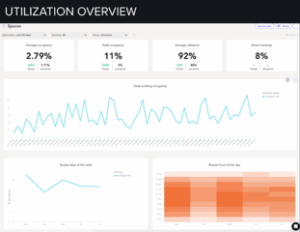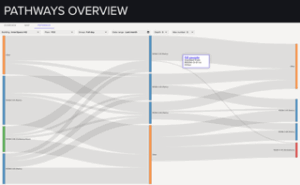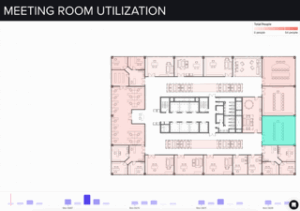In a rapidly changing world of work, corporate real estate (CRE) leaders are being asked to solve more and do so with less. From making smart investment and divestment decisions, to improving energy performance and adapting hybrid policies, the pressure is on to make real estate portfolios and workplaces more agile, efficient, and responsive.
But you can’t fix what you can’t see. That’s where behavioural based utilization data comes in.
Here’s how senior leaders are leveraging behavioral-based utilization data to solve the most pressing issues in corporate real estate today.
1. Smarter Investment & Divestment Decisions
With the future of office demand in flux, real estate leaders are undergoing pressure to right-size their portfolios. But gut feelings and outdated badge data aren’t enough.
Leadership teams need deeper occupancy insights to assess the true performance of every floor, building, or campus. With this data they can identify consistently underutilized areas and know exactly which spaces are worth keeping, reconfiguring, or letting go.
For example, a Fortune 500 client used InnerSpace to analyze their downtown HQ. The data revealed that two full floors were averaging less than 15% occupancy during the workweek. That insight led to a divestment strategy that saved $2.4 million in annual leasing and operating costs – without impacting employee experience.
2. Improving RTO and Hybrid Policy Effectiveness
Return-to-office policies have become one of the most politically charged topics in the workplace. Many organizations are stuck wondering: Are people coming in? Are our policies working? And how do we adapt without undermining trust?
Executive teams need real-time visibility into actual behaviors like how often teams come in, what days are busiest, and how shared spaces are being used. This allows leaders to measure policy performance objectively and adjust in a way that reflects reality.
One of our clients discovered that employees were consistently avoiding the office mid-week because of overcrowded meeting rooms on Tuesdays and Wednesdays. With our behavioral data, they rebalanced room allocations and encouraged more flexible scheduling, which led to higher in-office attendance and better collaboration outcomes.
3. Boosting Team Performance Through Environment Design
Workplace design has a massive impact on team productivity, but without behavioral data, it’s often based on assumptions.
Utilization data uncovers patterns in how people and teams actually use the space. Are certain zones overused while others sit empty? Are heads-down areas being used for calls and collaboration? Are teams co-locating or scattered?
With the ability to assign groups, managers can look at how their teams are working together and collaborating with others to gauge effectiveness of project teams or create best practices based on the behaviors of high performing teams.
With these insights, team leaders can also redesign environments that support the actual needs of employees – quiet zones for focused work, breakout spaces for collaboration, and social areas for connection. The result is not just higher utilization, but more effective space aligned with the way people actually work.
4. Energy Optimization and Sustainability Goals
CRE teams are also at the front lines of sustainability and ESG mandates. But keeping a large office fully powered, lit, and climate-controlled, even when it’s barely used, comes at a steep financial and environmental cost.
By integrating real-time occupancy data with building management systems (BMS), organizations can dynamically adjust lighting, HVAC, and cleaning schedules based on actual usage. This avoids waste and improves energy efficiency – without sacrificing comfort or employee experience.
A global consulting firm used InnerSpace to inform their HVAC strategy across three major offices. The result: a 17% reduction in energy consumption within one quarter and measurable progress toward their corporate net-zero goals.
Metrics That Matter
Traditional data sources, like badge swipes and occupancy sensors, provide a limited view of what is happening in your space. Advanced, sensor free, behavioral insights mean that you have access to the metrics that allow you to make data based decisions across your organization.
DWELL TIME
- How long employees or visitors spend in specific areas
- Identifies high-traffic zones vs. underutilized spaces
- Captures patterns of space usage throughout the day

OCCUPANCY TRENDS
- Real-time and historical space utilization data
- Tracks peak and low-traffic periods
- Identifies patterns in office attendance over time

MOBILITY PATTERNS
- How employees move through the space
- Tracks common pathways, congestion points, and bottlenecks
- Identifies which spaces encourage movement and collaboration

MEETING ROOM UTILIZATION
- Frequency and duration of meeting room usage
- Identifies underused or overbooked rooms
- Tracks no-shows and abandoned bookings

AMENITY USAGE
- Tracks how frequently amenities like cafeterias, lounges, fitness centers, and wellness rooms are used
- Identifies peak usage times to inform cleaning and maintenance schedules
- Measures whether certain amenities are underutilized
DESK UTILIZATION
- How often desks are occupied throughout the day
- Identifies trends in desk-sharing and hot-desking adoption.
- Tracks desk availability in real-time
CROSS TEAM COLLABORATION
- Tracks interactions between different teams and departments
- Identifies where collaboration occurs most frequently
- Measures impact of workplace layout on cross-functional teamwork
PRIVACY AND FOCUS SPACE UTILIZATION
- Tracks usage of quiet zones, focus pods, and private rooms
- Identifies whether employees are using designated focus spaces
- Measures the demand for quiet work environments
CUSTOM REPORTS
- Tailored Insights for Strategic Goals: Customize reports to focus on the metrics that matter most to your organization
- Automated Delivery and Scheduling: Set up reports to be delivered automatically on a recurring schedule
- Exportable and Shareable Formats: Generate reports in multiple formats (PDF, Excel, CSV) that are easy to export, analyze further, or share across departments, enabling data-driven collaboration across your organization.
The Bottom Line
Today’s CRE leaders need to be more agile, more strategic, and more cost-effective than ever before. Badge swipe data and basic occupancy data is no longer sufficient to make strategic, data based decisions about your workspace. Innovative leaders are leveraging behavioral based utilization data to inform all major workplace decisions and create more human centric environments.
If you’re making big decisions about your real estate portfolio, don’t do it in the dark. Light the way forward with advanced utilization data.
About InnerSpace
InnerSpace is a sensor free space utilization analytics platform designed for enterprise-scale leadership teams. What sets us apart is how we collect data: our platform runs entirely off your existing Wi-Fi network – no sensors, no cables, and no maintenance-heavy hardware to install.
Within a matter of days, InnerSpace leverages patented pHLF technology to transform any workspace into a real-time data source for behavioral-based occupancy insights. That means you get an immediate, high-resolution view of how employees and visitors are using your space, how often they come in, where they tend to work, and how different teams interact with the environment and with each other.
Our platform is passive, private, and completely sensor-free. You won’t need to disrupt your workplace or spend months on deployment. The results are transformative.
About James Wu
James Wu is a visionary technology leader and product design expert with over two decades of experience in user experience design, software development, and product innovation. As the Co-Founder and CEO of InnerSpace, he leads the company’s mission to transform workplace analytics through spatial intelligence, leveraging Wi-Fi-based technology for real-time space utilization insights.
With a Ph.D. in Computer Science from Queen’s University, he combines deep academic knowledge with hands-on leadership in product-driven organizations. His commitment to enhancing human experiences through technology has earned him multiple design awards and a reputation for driving innovation in the digital space.



